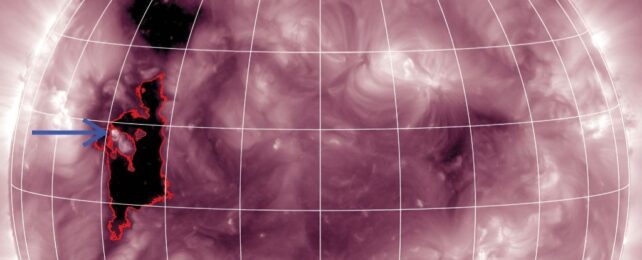A giant, gaping hole that opened up in the Sun's atmosphere has been identified as the source of a surprising abundance of a rare isotope of helium.
In late October 2023, the Sun was recorded belching out a simply enormous amount of helium-3 – the largest amount yet ever seen coming out of the Solar System's central star.
After conducting an investigation, astronomers traced the source back to a jet launched from the edge of a coronal hole as part of a rare solar eruption that was packed only with lighter elements.
"This rare isotope, which is lighter than the more common helium-4 by just one neutron, is scarce in our Solar System – found at a ratio of about one helium-3 ion per 2,500 helium-4 ions," explains astrophysicist Radoslav Bučík of the Southwest Research Institute in the US.
"However, solar jets appear to preferentially accelerate 3He to high speeds or energies, likely due to its unique charge-to-mass ratio."
Helium-4 is by far the most common isotope of helium. It makes up around a quarter of all the normal matter in the Universe by mass. Most of the helium-3 and helium-4 abundant throughout the Universe is thought to have formed in the moments after the Big Bang. Of the two, the smaller isotope is way less abundant.
Typically, helium-3 makes up around 0.002 percent of the solar wind. Solar jets can boost helium-3 to around 10,000 times its usual concentration in the solar atmosphere.
On 24 and 25 October 2023, however, ESA and NASA's Solar Orbiter observatory detected helium-3 whooshing away from the Sun in concentrations 180,000 times greater than its usual concentration in the Solar atmosphere, to higher speeds than most of the other material in the outflow.
On those days, solar observatories recorded the presence of a large coronal hole on the face of the Sun. Coronal holes are temporary regions in the solar corona, or atmosphere, where a gap in the magnetic field forms. They can't be seen in visible light, but in ultraviolet and X-ray images they appear quite dark. This is because the plasma in these patches is cooler and less dense than the surrounding material.
With the magnetic fields leakier than usual, the solar wind can escape more readily, pushing charged particles out into space at high speeds. On the fringes of this particular coronal hole, Bučík and his colleagues identified a highly collimated plasma flow known as a solar jet as the source of the solar particle event that included the high abundance of helium-3.
"Surprisingly, the magnetic field strength in this region was weak, more typical of quiet solar areas rather than active regions," Bučík says. "This finding supports earlier theories suggesting that helium-3 enrichment is more likely in weakly magnetized plasma, where turbulence is minimal."
What's even more interesting about this particular jet is what else was in it. Solar particle events, in which particles are accelerated in or from the solar corona, can contain high concentrations of helium-3; but no matter the helium-3 contents, they typically contain high concentrations of other, heavier elements, from neon to iron.
In the solar particle event of October 2023, iron hadn't increased significantly. Rather, the outflow had an abundance of elements such as carbon, nitrogen, silicon, and sulfur. Only 19 other solar particle events between 1999 and 2023 had similar chemical profiles.
One possibility is that such events are rare. The other possibility is that they are fairly common, they're just usually pretty weak, and we're just not close enough to the Sun to see and measure them.
Solar Orbiter sits roughly half way between Earth and the Sun, putting it in a comfortable position for capturing the wild variety of our closest star's mysterious outbursts.
The research has been published in The Astrophysical Journal.
